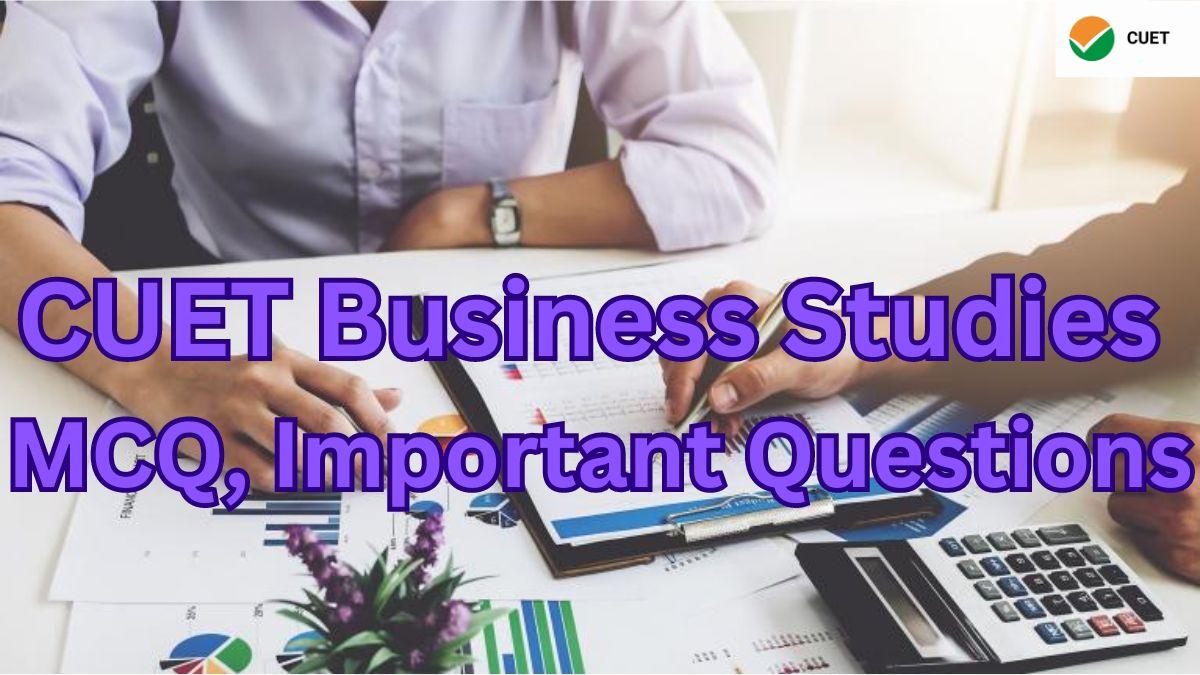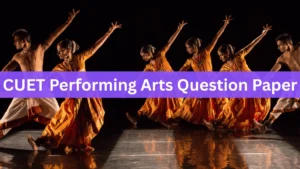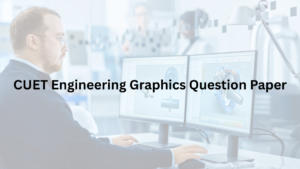Table of Contents
CUET Business Studies Previous Year Question Paper 2025: The CUET Business Studies exam 2025 is conducted to pursue business administration, management, or similar areas at the undergraduate level. If you want to solve the Business Studies Paper 2025 very confidently, then you must focus on the important chapters and practice with important questions. To achieve high marks in the CUET Business Studies (BST) exam, students must answer all the CUET Business Studies MCQs and key questions from this article.
CUET Business Studies Question Paper 2025
According to the National Test Agency (NTA), the CUET Exam 2025 will soon take place from May 8 to June 1, 2025. Language Tests, Domain-Specific Tests, and General Tests are the three divisions of each CUET UG paper. The only courses in Section 2 of the CUET test are those that are domain-specific.
As a result, performing well in the CUET Business Studies Question Paper 2025 is a requirement for students who want to pursue business and commerce courses in their undergraduate degree. To determine their strengths and weaknesses, students should first go through the business studies practice set. Every key topic covered in the CUET Business Studies gives students a thorough understanding of each topic and subtopic.
CUET Business Studies Question Paper: Pattern
The National Testing Agency (NTA) publishes the CUET UG Business Studies Exam Pattern 2025 as well as for other subjects. To familiarize yourself with the exam pattern and exam day environment, practice the previous year’s CUET Business Studies Question paper. For more information on the paper pattern, see the table below.
| CUET UG Business Studies Paper Pattern 2025 | |
| Particulars | Details |
| Exam Name | CUET UG Business Studies |
| Mode |
Computer-based-test (CBT)
|
| Sifts |
Two to three
|
| Type of questions |
Multiple Choice Questions (MCQs)
|
| CUET UG sections |
|
| Total number of questions | Section 1: 50 questions Section 2: 50 questions Section 3: 50 questions |
| Exam duration |
60 minutes/ 1 hr for each test paper
|
| Marking scheme |
|
CUET Business Studies Question Paper PDF Link
Students can download the Question paper of Business Studies 2025 exam from NTA’s main website (nta.ac.in). Candidates wishing to take the BST paper can download the CUET previous year question papers for all sections from the table below.
| Download BST Question Paper PDF Year Wise |
| CUET Business Studies Question Paper 2025 |
| CUET Business Studies Question Paper 2024 |
| CUET Business Studies Question Paper 2023 |
CUET Business Studies Important MCQ Questions
Check out the Chapter-wise CUET Business Studies Important Questions
CHAPTER 1: NATURE AND SIGNIFICANCE OF MANAGEMENT
Check the important CUET Business Studies MCQs below for Chapter 1.
1. Ritu is working as a marketing manager in a company, she has been given the task of selling 100000 units of a product at the cost of ₹100 per unit within 20 days. She is able to sell all the units within the stipulated time, but had to sell last 1000 units at 20% discount in order to complete the target. In such a situation, she will be considered to be
(a) An efficient manager
(b) An effective manager
(c) Both effective and efficient manager
(d) None of the above
2. Gangotri Limited is planning to increase its sales by 40% in the next quarter. Identify the feature of management being highlighted in the given statement.
(a) Management is all pervasive
(b) Management is a goal-oriented process
(c) Management is a continuous process
(d) All of the above
3. Management of Harshit Ltd. fulfils all its objectives and the organization is able to work effectively and efficiently. It is using environment friendly methods of production and disposing off the waste material either by recycling it or using the same for landfill in such a manner that the aquatic life is not disturbed. It also provide employment opportunities to the disadvantaged sections of the society. Identify the objective of management of Harshit Ltd. which it wants to fulfil by doing the above activities.
- Personal Objectives
- Organisational Objectives
- Social Objectives
- Both (a) and (b)
4. Management is considered to be an art because
- The principles of management have universal validity
- The principles of management have universal application
- Different principles of management are brought into effect differently by different managers
- It is not important for the practising managers to be a member of a professional association.
5. Which of the following statements does not pertain to middle level management?
(a) They are responsible for all the activities of the operational managers.
(b) They are responsible for the welfare and survival of the organisation.
(c) The interpreter the policies made by top level managers
(d) Co-operate with other departments for the smooth running of the organisation.
6. The main task of this level of management is to determine the overall organisational objectives and strategies for their realisation.
- Operational management
- Middle level management
- First line managers
- Top level management
7. Which of the following statements is not true for lower level management?
(a) Analyse the business environment and its implications for the survival of the business.
(b) Ensure the quality of the output
(c) They strive to reduce the wastage of resources
(d) They ensure that the safety standards are maintained within the organisation.
8. Successful organisations do not achieve goals by chance but by following a deliberate process known as
- Planning
- Co-ordination
- Controlling
- Management
9. Co-ordination is considered to be the essence of management because
(a) It is a common thread that runs through all the activities within the organisation
(b) It is implicit and inherent in all functions of the organisation
(c) It is a force that binds all the functions of management
(d) All of the above
10. Management is essential for those organisations which are –
- Service Organisations
- Business Organisations
- Non-Profit Organisations
- All of these
CHAPTER 2: PRINCIPLES OF MANAGEMENT
The CUET Business Studies important questions for the chapter principles of management has been provided hereunder.
1. Rama employment is a company which takes care of the fact that the confidence of the employees should always be at its peak. For this reason they give surety to their employees for employment for a minimum fixed tenure of time. Which principle of management is followed here?
- Stability of personnel
- Subordination of Individual interest to General interest
- Esprit de corps
- Equity
2. Radhika opens a jewellery showroom in Jaipur after completing a course in jewellery designing. She has employed eleven persons in her showroom. For greater productivity, she divides the work into small tasks and each employee is trained to perform his/her specialised job. The sales persons are allowed to close a deal with a buyer by giving a maximum of 10% discount, whereas the decision to give any further discount rests with Radhika as the final authority. In the earlier days of starting of the business, five of her employees were asked to put in extra hours of work. In return she had promised to give them a special incentive within a year. Therefore, after six months when the business was doing well, she awarded a cash bonus to each of these employees to honour her commitment. However, when it comes to settling the conflicts among her employees, she tends to be more biased towards her female employees. Identify the principle of management which is being violated by Radhika.
- Unity of Direction
- Equity
- Esprit de corps
- Initiative
3. Tushar owns a small scale factory where utility items are prepared from waste material like paper and cloth bags, decorative material etc. Over the past few weeks, he was observing that the productivity of one of his very efficient worker, Ramdas, is going down. So he decides to probe into the matter and confronts Ramdas one day. On being asked, Ramdas shares with Tushar that he has deliberately slowed down in his work as many of the less efficient workers often pull his leg saying that there is no need for him to be more efficient when everybody is being paid at the same rate. Taking a lesson from this insight, Tushar decides to implement an incentive bonus plan so as differentiate between efficient and inefficient workers. Name and explain the incentive bonus plan that Tushar may implement so as differentiate between efficient and inefficient workers. Name the incentive bonus plan that Anshul may implement so as differentiate between efficient and inefficient workers.
- Equity
- Functional foremanship
- Differential piece wage system
- Work study
4. A scientist working in a factory for the betterment of the operational aspect studied all the steps involved in the manufacturing of the product. He very attentively noticed all sorts of movements to arrive at a simpler way of doing all the activities possible. With his hard work he was able to bring down the number of activities for the manufacturing of the final product from 34 to 22. This work was able to bring down the labour charges and decrease the total time of production. Thus he gave the organisation an added advantage. Which type of scientific technique is discussed here?
- Motion study
- Time Study
- Fatigue Study
- Method Study
5. A floor manager of a Mall is very capable as he utilises all the functions of management. He lays stress on developing mutual trust and spirit of cooperation amongst the employees. Under his guidance the employees admit that they learn a lot and are able to meet their targets. This has led to increase in their salaries.
Identify the principle of Fayol followed by the floor manager in the above case.
- Esprit de corps
- Stability of personnel
- Unity of Command
- Discipline
6. In the festive season, Malhotra Industries (leading manufacturers of gift items) decided to reduce the rest interval of workers from 40 minutes to just 8 minutes. However, due to heavy work load and reduction in time of rest interval, the workers’ efficiency level went down and it led to fall in production level, instead rising. Which technique of Scientific management should be followed by Malhotra Industries ?
- Motion study
- Method study
- Fatigue study
- Time study
7. Arjun, a manager, very often speaks to people at all levels, passing on instructions regarding his department and other departments. State the management principle being violated here.
(a) Equity
(b) Scalar chain
(c) Order
(d) None of the above
8. Karan, the purchase manager of Ram Ltd., has to purchase 50 tones of raw material. He purchased the raw material from a company owned by his relative., at a rate more than the market price. Explain the principle of management which is being violated in the given example.
- Subordination of Individual interest to General Interest
- Stability of Tenure of personnel
- Unity of Direction
- None of these
CUET Previous Year Question Paper
9. “Madhu drafts instructions for the workers”. Whose work is being described by this sentence under functional foremanship ?
- Route clerk
- Instruction card clerk
- Time and cost clerk
- Disciplinarian
10. Mr. Gajendra, the salesman in Nokia Ltd., designed a new cost saving advertisement technique through his personal experience and suggests the same to his sales manager but it was not appreciated by his sales manager and he also warned him not to come with any suggestions in future. Which principle of Fayol is being overlooked by the sales manager? What should have been the appropriate way of response by the sales manager?
- Order
- Stability of personnel
- Equity
- Initiative
CHAPTER 3: PLANNING
The CUET Business Studies important questions for the Planning chapter has been provided hereunder.
1. Raghavi wants to start a stationery shop to help students of schools and colleges to provide stationery to them. She felt that students were not able to get the needed stationery easily and hence wanted to provide the stationery directly to students on school. She list out various ways of setting up the business and finally selected the best way to set up this business by developing an app. What would be next step of Planning in the above case?
- Developing Premises
- Implementation of Plan
- Follow up action
- Identifying the alternative courses of action
2. ‘Swatch Bharat Abhiyan’ started by Government of India is an example of which type of plan?
- Rule
- Policy
- Programme
- Objective
3. Super Electronics is offering a free D.V.D player on purchase of a T.V.In response to this Modern Electronics started a new scheme of giving free keypad phone on purchase of T.V.
Identify the plan stated in the above paragraph.
- Objective
- Strategy
- Policy
- Rule
4. Kumar is given target to produce 15 units per day, but due to his habit of doing things differently an idea struck him, which not only will increase the capacity of all employees but also will also help in reducing production costs. But instead of appreciating his idea, his supervisor instructed him to do work as per prescribed technique. Identify the limitation of Planning highlighted in the above case?
- Planning is a time consuming process
- Planning leads to rigidity
- Planning reduces creativity
- Planning involves huge costs
5. Umesh Ltd. spent a lot of money to hire specialized people for framing their plans and collecting important facts about environment. The company cut down their cost by cancelling the employee’s trip for recreation. Name the limitation of Planning mentioned in the above para.
- Planning may not work in dynamic environment
- Planning leads to rigidity
- Planning is time consuming process
- Planning involves huge costs
6. According to a survey, these days the young children have more power in purchasing decisions than ever before. The parents seek their kids’ opinions about all kinds of once-adult decisions, including where to go for dinner, what kind of car to buy, even what to wear,”. Therefore, the retailers are adapting to this by enhancing their kids’ sections. If the children want to shop in the store for their clothes, then there’s a greater chance the parent will also see something they want to buy as well. Identify the type of plan being described in the above lines.
(a) Programme
(b) Method
(c) Strategy
(d) Rule
7. The ‘Leela’ hotel has decided to employ female staff for handling kitchen affairs and male staff for marketing issues. Identify the type of plan reflected here.
(a) Programme
(b) Method
(c) Strategy
(d) Policy
8. A reputed car manufacturing company in NCR is facing problem of decline in its market share due to its internal mismanagement. Therefore, it has planned to increase its production capacity at its Gurugram plant by manufacturing low priced ecofriendly cars for price sensitive consumers and introducing new models with added features for quality conscious consumers. Name the type of plan followed by management of the company.
(a) Programme
(b) Method
(c) Strategy
(d) Rule
9. Lakshay, production Manager of Future Ltd. is planning to install a new machinery for increasing production capacity. He compare various models and brands of machinery available. He also discuss with supervisors, workers, compare initial cost, maintenance cost and other overheads before taking final decision about the machinery to be installed. Identify the step of the planning process performed in the above para
(a) Selecting an alternative
(b) Evaluating Alternative Courses
(c) Identifying Alternative Courses of action
(d) Developing Premises
10. In a visit to restaurant, some youngsters were found smoking in spite of sign board indicating ‘No Smoking Zone’. Name the type of plan referred in the given para.
(a) Method
(b) Objective
(c) Strategy
(d) Rule
CHAPTER 4: ORGANISING
The CUET Business Studies MCQ important questions for the “organising” chapter has been provided below.
1. Sahil has been given the task of arranging for five-day conference for foreign delegates. In order to ensure smooth functioning of the event, he has made two people as co-ordinators to take care of activities related to registration and refreshment. Identify the function of management being carried out by Sahil.
(a) Planning
(b) Staffing
(c) Organising
(d) Directing
2. Which of the following is not an advantage of delegation?
(a) Effective management
(b) Better control
(c) Employee’s development
(d) Basis of Basis of management hierarchy
3. The function of organising allows the enterprise to adjust itself according to the change in business environment by suitably modifying the organisation structure.. Which importance of Organising is referred to here?
(a) Clarity in working relationship
(b) Adaptation to change
(c) Development of personnel
(d) Expansion and growth
4. Arrangement the following steps in the process of organizing in the correct sequence:
(i) Assignment of duties
(ii) Departmentalisation
(iii) Identification and division of work
(iv) Establishing reporting relationship
Choose the correct option:
(a) (i), (ii), (iv), (iii)
(b) (iii), (ii), (i), (iv)
(c) (iii), (ii), (iv), (i)
(d) (ii), (iii), (i), (iv)
5.Which of the following is a disadvantage of functional structure?
(a) Difficulty in inter-departmental coordination
(b) Helps in increasing managerial efficiency
(c) Minimises cost
(d) Coordination is established
6. In a company, top level management has not distributed work among the subordinates according to their abilities and skill but has been distributed on the basis of caste and religions. Identify the step of the organizing function not followed by the management.
(a) Assignment of duties
(b) Identification and division of work
(c) Departmentalisation
(d) Establishing reporting relationships
7. Authority granted to an employee should be
(a) More than the responsibility entrusted to him
(b) Less than the responsibility entrusted to him
(c) Equal to the responsibility entrusted to him
(d) All of the above
8. It helps the managers to ensure that their subordinate discharges his duties properly.
(a) Responsibility
(b) Authority
(c) Accountability
(d) All of the above
9. Rama Foods Limited’ is a famous company making different food materials. Mr. Vikram is the Managing Director of the company. He is fully attached to the employees of his company. This is the main reason that before taking any decision he consults all the concerned employees. A suggestion box has also been provided in the company. It is opened once in fifteen days. The employees giving positive suggestions are suitably rewarded. Besides, all the employees of the company also enjoy complete freedom to communicate with any senior officer any time, for all types of matter whether it is job related or personal. Identify the type of organization highlighted in the above case.
(a) Formal Organisation
(b) Informal organisation
(c) Divisional structure
(d) None of these
10. Jagdish Ltd. has been awarded recently with the ‘Best Employer of the Year Award’. The company has believed in the ideas and suggestions of the employees. There is systematic dispersal of decision making at all levels. There is no delay in delivery of orders to customers due to prompt decision taken by employees. Identify the function of management referred in the above case-
(a) Responsibility
(b) Delegation
(c) Planning
(d) Decentralisation
CHAPTER 5: STAFFING
The CUET Business Studies MCQ important questions for the chapter “Staffing” is given below.
1. It is suitable for filling casual vacancies when work load is high or when certain number of permanent workers are absent.
- Direct recruitment
- Labour contractors
- Advertising on television
- Placement agencies and management consultants
2. Under this method of recruitment, an organisation maintains a database of unsolicited applicants in their offices.
- Direct recruitment
- Casual callers
- Labour contractors
- Advertising on television
3. This source of recruitment basically specialises in filling up the vacancies at the middle level and top level management.
- Direct recruitment
- Labour contractors
- Advertising on television
- Placement agencies and management consultants
4. It is a very useful source of recruitment for hiring casual or ‘badli’ workers to whom compensation is provided on a daily wage basis.
- Placement agencies and management consultants
- Direct recruitment
- Labour contractors
- Advertising on television
5. Many big organisations maintain a close liaison with the universities, vocational schools and management institutes to recruit qualified personnel for various jobs. This is known as
(a) Placement agencies and management consultants
(b) Direct recruitment
(c) Labour contractors
(d) Campus recruitment
6. Read the given case study and answer the questions that follow (Q46 to Q49)
Chandan Public School had a vacancy of Science teacher. They were looking for a smart and creative teacher who is excellent in his/her field. An advertisement was given in all the leading newspapers. Since the response was huge, the school all the application forms and rejected the candidates who did not have the necessary qualifications. Thereafter, a test was conducted to measure the existing skills of the candidates. After that it was followed by a formal-in-depth conversation with the principal of the school and a panel of Science experts.
- ‘ An advertisement was given in all leading newspapers’. What is advantage of using this source of recruitment?
- It gives wider choice
- It is a lengthy process.
- It motivates the existing employees of the organization.
- All of these
2. ‘Since the response was huge, the school examined all the application forms and rejected the candidates who did not have necessary qualification’. Which step of recruitment is reflected here?
- Selection decisions
- Job offer
- Preliminary Screening
- Reference checks
3. ‘Thereafter a test was conducted to measure the existing skills of the employees ‘. The aim of this test is :
- To eliminate unfit job seekers.
- To measure certain characteristic of the individual.
- To gain additional information about the candidate.
- To ensure trustworthiness of the candidate.
4. ‘After that it was followed by a formal in depth conversation with the Principal of the school and panel of Science experts.’ Which of the following statement is not true about this step of recruitment?
- This step precedes selection test
- The interviewer seeks information from the interviewee.
- It can be face to face or on phone.
- The interviewee also seeks information from interviewer.
5. Which type of training is provided to the new employees in an organization in order to familiarize them with the organizational rules and policies, their superiors and subordinates and so on?
- Vestibule Training
- Apprenticeship Training
- Internship Training
- Induction Training
To Know the ANSWERS OF THESE QUESTIONS, DOWNLOAD ADDA247 APP
For more details on CUET EXAM 2022 follow the YouTube Channel @cuetadda247.
Syllabus Of Business Studies For CUET
Before delving into the CUET Business Studies MCQ important questions, first let yourself get versed with the latest CUET Business Studies syllabus. The official syllabus in detail for the CUET Business Studies exam has been provided below.
| Download PDF |
| CUET Business Studies Syllabus 2025 |
Get more information from our latest articles –




 Scoring 900+ in CUET is More Than Possib...
Scoring 900+ in CUET is More Than Possib...
 CUET Performing Arts Question Paper 2025...
CUET Performing Arts Question Paper 2025...
 CUET Engineering Graphics Question Paper...
CUET Engineering Graphics Question Paper...




